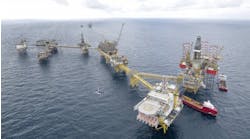BP has contracted 2H Offshore Engineering Ltd. to design and supply a monitoring and response evaluation system for the drilling riser deployed by the drillshipDiscoverer Enterprise. Owned by Transocean and designed to operate in ultra-deepwater, the vessel is under contract to BP for work on the oil company's Thunder Horse prospect in 1,800 m of water in the Gulf of Mexico. The monitoring system, due to be installed in September, will provide structural response information along the entire riser length in real time to confirm its structural integrity and support drilling operations.
The project will aid understanding of the behavior of deepwater risers subject to high marine currents, particularly where vortex-induced vibration (VIV) is a factor. It builds on previous monitoring campaigns conducted by 2H that have used stand-alone instruments recording response data into memory. The monitoring system will provide data at the surface in real time and give the clearest information yet on the complex problem of VIV response and its associated fatigue damage. The data collected will also greatly assist offshore operations, allow inspection requirements to be optimized, and hence reduce the risks that are inherent in such operations. It will also provide valuable input to the design of future riser systems.
The monitoring system is expected to work for 20 years and, based on past experience, the riser will be deployed and retrieved about five times a year. A major practical challenge will be to design the monitoring system so that it can be run without disrupting drilling operations.
The system proposed by 2H is based on self-contained motion monitors capable of capturing very small movements of the riser. Similar devices have been supplied to several operators over the last five years – in fact, there have been over 250 monitors deployed to date.
Key features of the motion monitors are their compactness, low power requirement and high reliability – 99.9% in recent applications. The monitors on theDiscoverer Enterprise riser will include sensors to measure triaxial acceleration and 2-plane angular rate.
There will be up to 30 monitors attached at intervals along the drilling riser. Rather than logging the data locally for post-processing, as has been the case in most previous applications, the monitors will all be connected into an umbilical leading to the surface. The electronic architecture, the instrument configuration and the communications protocols have all been designed for maximum reliability. Data will be collected constantly and processed immediately to provide information on the modes of vibration that the riser is experiencing. From this information, engineers will be able to calculate riser fatigue damage rates.
According to Steve Hatton, 2H's decision to use motion sensing rather than strain measurement (an area in which 2H is also heavily involved) is based on the motion sensors' long-term reliability and low cost.
"This is a very complex monitoring system that will utilize a lot of instruments," Hatton says. "They are expected to last for a long time and to monitor small movements to a high degree of accuracy. These fundamental requirements have been at the front of our minds during every stage in the design proposal and as such have had a great impact on the final solution."
01/19/05


